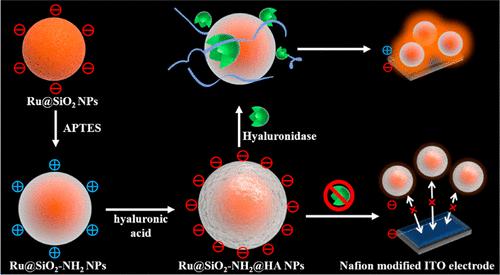Our official English website, www.x-mol.net, welcomes your feedback! (Note: you will need to create a separate account there.)
Electrochemiluminescence Biosensor for Hyaluronidase Based on the Adjustable Electrostatic Interaction between the Surface-Charge-Controllable Nanoparticles and Negatively Charged Electrode
ACS Sensors ( IF 8.9 ) Pub Date : 2022-06-22 , DOI: 10.1021/acssensors.2c00801 Zhixin Li 1, 2 , Xiaoli Huang 3 , Hongning Liu 1 , Fang Luo 2 , Bin Qiu 2 , Zhenyu Lin 2 , Huixing Chen 4
ACS Sensors ( IF 8.9 ) Pub Date : 2022-06-22 , DOI: 10.1021/acssensors.2c00801 Zhixin Li 1, 2 , Xiaoli Huang 3 , Hongning Liu 1 , Fang Luo 2 , Bin Qiu 2 , Zhenyu Lin 2 , Huixing Chen 4
Affiliation

|
A novel electrochemiluminescence (ECL) biosensor for hyaluronidase (HAase) based on the adjustable electrostatic interaction between the surface-charge-controllable nanoparticles and negatively charged electrode has been devised. Hyaluronic acid (HA)-coated amino-modified ruthenium bipyridine-doped silica nanoparticles (Ru@SiO2–NH2@HA NPs) have been synthesized and act as ECL indicators, and the surface of this particle is negatively charged because HA contains a large amount of OH– and COO–. The strong electrostatic repulsion between the Ru@SiO2–NH2@HA NPs and negatively charged indium tin oxide (ITO) electrode surface leads to the detection of a low-intensity ECL signal. In the presence of HAase, the HA on the surface of the Ru@SiO2–NH2@HA NPs can be decomposed, and the particles can be transformed into positively charged amino-modified ruthenium bipyridine-doped silica nanoparticles (Ru@SiO2–NH2 NPs), which can be concentrated near the surface of the ITO electrode through electrostatic attraction, and result in the detection of an enhanced ECL signal. The ECL of the system has a good linear relationship with HAase concentration in the range of 2.0–60 U/mL, and the limit of detection was 0.37 U/mL. The designed biosensor had been applied to detect the target in real samples with satisfied results.
中文翻译:

基于表面电荷可控纳米粒子与负电荷电极之间可调节静电相互作用的透明质酸酶电化学发光生物传感器
设计了一种基于表面电荷可控纳米粒子和带负电电极之间可调节静电相互作用的透明质酸酶 (HAase) 新型电化学发光 (ECL) 生物传感器。合成了透明质酸 (HA) 包覆的氨基改性钌联吡啶掺杂二氧化硅纳米粒子 (Ru@SiO 2 –NH 2 @HA NPs) 并作为 ECL 指示剂,该粒子表面带负电荷,因为 HA 含有大量的 OH- 和 COO-。Ru@SiO 2 -NH 2 @HA NPs 和带负电的氧化铟锡 (ITO) 电极表面之间的强静电排斥导致低强度 ECL 信号的检测。在 HAase 存在下,Ru@SiO 表面上的 HA2 –NH 2 @HA NPs 可以分解,颗粒可以转化为带正电的氨基修饰的钌联吡啶掺杂二氧化硅纳米颗粒(Ru@SiO 2 –NH 2 NPs),可以集中在 ITO 表面附近电极通过静电吸引,并导致检测到增强的 ECL 信号。系统的ECL与HAase浓度在2.0~60 U/mL范围内具有良好的线性关系,检出限为0.37 U/mL。所设计的生物传感器已应用于检测实际样品中的目标,结果令人满意。
更新日期:2022-06-22
中文翻译:

基于表面电荷可控纳米粒子与负电荷电极之间可调节静电相互作用的透明质酸酶电化学发光生物传感器
设计了一种基于表面电荷可控纳米粒子和带负电电极之间可调节静电相互作用的透明质酸酶 (HAase) 新型电化学发光 (ECL) 生物传感器。合成了透明质酸 (HA) 包覆的氨基改性钌联吡啶掺杂二氧化硅纳米粒子 (Ru@SiO 2 –NH 2 @HA NPs) 并作为 ECL 指示剂,该粒子表面带负电荷,因为 HA 含有大量的 OH- 和 COO-。Ru@SiO 2 -NH 2 @HA NPs 和带负电的氧化铟锡 (ITO) 电极表面之间的强静电排斥导致低强度 ECL 信号的检测。在 HAase 存在下,Ru@SiO 表面上的 HA2 –NH 2 @HA NPs 可以分解,颗粒可以转化为带正电的氨基修饰的钌联吡啶掺杂二氧化硅纳米颗粒(Ru@SiO 2 –NH 2 NPs),可以集中在 ITO 表面附近电极通过静电吸引,并导致检测到增强的 ECL 信号。系统的ECL与HAase浓度在2.0~60 U/mL范围内具有良好的线性关系,检出限为0.37 U/mL。所设计的生物传感器已应用于检测实际样品中的目标,结果令人满意。



























 京公网安备 11010802027423号
京公网安备 11010802027423号